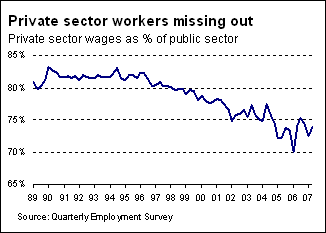Generous to a fault
The Labour government has been very generous to its public servants. Since Labour’s election in 1999, average ordinary time wages in the public sector have increased by 34% compared with 25% increases in private sector wages. In 1999 private sector wages were on average 79% of those prevailing in the public sector, today they are around 74% of public sector wages.

Typically wage rates are influenced by the ability of workers (eg their skills, experience, diligence, and intelligence), the performance of their employer (i.e. their ability to reward workers), and the relative bargaining power between workers and employers. One could argue that wage increases in the public sector simply reflect the employment of more high-ability workers. But even if this is the case, the increase in public sector wages must also reflect the willingness and ability of government agencies to pay higher wages.
The government’s financial position has definitely been sound in recent years. Reductions in debt servicing costs and a higher tax take have allowed the government to increase its non-finance-cost core spending by 45% in the last five years – a period when nominal GDP increased by just 32%.
Public sector wages have also been boosted by the promotion of collective bargaining via the Employment Relations Act 2000. A key justification for the promotion of collective bargaining is a perspective that there is an "inherent inequality of power in employment relationships".
There is no provision within the Act for addressing circumstances where the inherent inequality favours employees. Yet public sector employment relations are such a case. To begin with, governments’ statutory powers to raise taxes mean that they do not face the same type of immediate financial pressures that inhibit wage rises in most private firms. In addition, it is difficult for citizens, the ultimate employers of public sector workers, to ensure that they are well represented in the wage negotiation process.
Government activities are funded by taxpayers for the benefit of the nation’s citizens. The interests of citizens are entrusted to politicians to make strategic decisions on their behalf, to public sector managers to organise the delivery of public sector services, and to public sector employees to implement the delivery of these services.
There are natural conflicts of interest between each of these parties and their ultimate employers, the citizens. Using public sector wages to illustrate: high wages improve the wellbeing of employees at the expense of taxpayers, yet the threat of unemployment to public sector workers from excessive wage demands and industrial action are negligible compared with the private sector. In addition, the political fall-out of industrial actions are potentially more serious to politicians than the cost of higher wages, which can be spread thinly across all taxpayers.
Unionisation in New Zealand is a largely public sector phenomenon. According to Department of Labour data, 211,123 of the total 373,117 union members in March 2006 were members of unions associated with government-dominated industries (i.e. the Government Administration and Defence, Health and Community Services, and Education industries). Relating this information to employment data implies that unionisation in these three government-dominated industries is around 58% of employment. Unionisation in the rest of the economy is around 12% of employment.
Promoting collective bargaining in the public sector seems a recipe for excessive public sector wage growth. Although a key purpose of government activities is to redistribute incomes from the wealthy to the less fortunate, it is not obvious that public servants, teachers, and medical practitioners are the "unfortunates" most of us have in mind.
What can be done to improve the social returns from tax-funded government spending? One approach is to impose stronger spending constraints in order to encourage government agencies to resist pay increases with more resolve and for them to seek smarter ways of doing things to fund the wage rises that are agreed to. It is interesting to note that during the 1990-1996 period, when public sector spending restraint was imposed with rigour, that it was also a period of comparative balance between private and public sector wages (see graph).
Public sector managers should be assisted here by reducing public sector union power. This does not necessarily mean de-unionisation in the public sector. There is already an alternative model for rationalising public sector pay negotiations: ban public sector industrial action and replace it with arbitration as the ultimate dispute resolution process. This process has been used by police for many years in New Zealand. It is a process that has not diminished union membership in the police or the employment conditions of police officers. But arbitration enables bargaining power to be shifted away from the ability of unions to disrupt the provision of public services and onto the cogency of the arguments and evidence produced by the negotiating parties.





